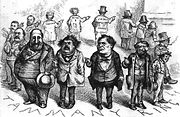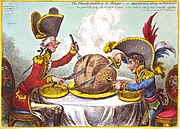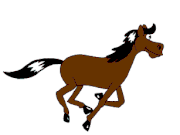Portal:Cartoon

A cartoon is a type of visual art that is typically drawn, frequently animated, in an unrealistic or semi-realistic style. The specific meaning has evolved, but the modern usage usually refers to either: an image or series of images intended for satire, caricature, or humor; or a motion picture that relies on a sequence of illustrations for its animation. Someone who creates cartoons in the first sense is called a cartoonist, and in the second sense they are usually called an animator.
The concept originated in the Middle Ages, and first described a preparatory drawing for a piece of art, such as a painting, fresco, tapestry, or stained glass window. In the 19th century, beginning in Punch magazine in 1843, cartoon came to refer – ironically at first – to humorous artworks in magazines and newspapers. Then it also was used for political cartoons and comic strips. When the medium developed, in the early 20th century, it began to refer to animated films that resembled print cartoons. (Full article...)

In print media, a cartoon is a drawing or series of drawings, usually humorous in intent. This usage dates from 1843, when Punch magazine applied the term to satirical drawings in its pages,[1] particularly sketches by John Leech.[2] The first of these parodied the preparatory cartoons for grand historical frescoes in the then-new Palace of Westminster in London.[3]

Sir John Tenniel—illustrator of Alice's Adventures in Wonderland—joined Punch in 1850, and over 50 years contributed over two thousand cartoons.[4]
Louis Riel is a 2003 historical biography in comics by Canadian cartoonist Chester Brown. It deals with the relationship of Métis rebel leader Louis Riel (pictured) with the newly established Canadian government. It begins shortly before the 1869 Red River Rebellion, and ends with Riel's 1885 hanging for high treason. The book explores the possibly schizophrenic aspect of Riel's personality—he believed God had named him Prophet of the New World, destined to lead the Métis people to freedom. The work is noted for its emotional disengagement, its intentionally flat dialogue, and a minimalist drawing style inspired by Harold Gray's comic strip Little Orphan Annie. The lengthy, hand-lettered appendix provides insight on Brown's creative process and biases, and highlights where he changed historical facts to create a more engaging story. It was the first comic book to receive a grant from the Canada Council for the Arts. It was critically well received, and won three Harvey Awards. The original serialization (1999–2003) sold poorly, but the book version was a surprise bestseller. Its success played a major part in gaining shelf space for serious graphic novels in mainstream North American bookstores.
Anarky is a fictional character in the DC Comics Universe. Co-created by Alan Grant and Norm Breyfogle, he first appeared in Detective Comics #608 (November 1989) as an adversary of Batman. Stories revolving around Anarky often focus on political and philosophical themes. Named after the philosophy of anarchism, the primary philosophical element that has underscored the character's appearances has been anti-statism. With Grant's transition to the philosophy of Neo-Tech, Anarky was transformed from a vehicle for socialist and populist philosophy, to rationalist, atheist, and free market based thought. Inspired by multiple sources, early stories to feature the character often included homages to political and philosophical books. The creation of the character was also partially influenced by Alan Moore's character "V" from V for Vendetta. Originally intended to only be used in the debut story in which he appeared, positive reception by readers and his editor convinced Grant to continue using Anarky as a recurring character throughout the early 90s. This popular acclaim culminated, however, in a financially and critically unsuccessful ongoing solo series. The 1999 Anarky series, in which even Alan Grant has expressed his distaste, was quickly canceled after eight issues.
- ...that 1999's Scooby-Doo! Mystery of the Fun Park Phantom was the first commercial Scooby-Doo computer game for the Windows platform?
- ...that the Sam Sheepdog and Ralph Wolf cartoons Sheep Ahoy, A Sheep in the Deep, and Don't Give Up the Sheep were censored by ABC to remove a dynamite stick, a smoke break scene, and a spanking scene respectively?
- ...that The World of Strawberry Shortcake, the first television special to feature American Greetings' popular character, was rejected by the major U.S. networks and premiered in syndication instead?
The episodes of The Bellflower Bunnies, a children's animated series based on the Beechwood Bunny Tales books by Geneviève Huriet, Amélie Sarn and Loïc Jouannigot. It debuted on TF1, a French television network, on 24 December 2001. The series is written by Valérie Baranski, and produced by Patricia Robert. The show centres on the adventures and exploits of the Bellflower family, a clan of seven rabbits who live in Beechwood Grove. The two adults in the family, Papa Bramble and Aunt Zinnia, take care of their five children: Periwinkle, Poppy, Mistletoe, Dandelion and Violette. The series has also been broadcast on CBC Television and TFO in Canada, KI.KA in Germany, Portugal's RTP in the Azores, and in several other countries. The show has fifty-two episodes: four in the first season, twenty-two in the second, and twenty-six in the third. In the entire series, thirteen are based directly on installments in Beechwood Bunny Tales, published by Milan Presse of France and Gareth Stevens in the United States; the rest are based on scripts by Valérie Baranski. Distributors in Europe, North America, and South Korea have released DVDs of the first two seasons.
Jean-Claude Mézières (born 23 September 1938) is a French comic strip artist and illustrator. Born and raised in Paris, he was introduced to drawing by his older brother and influenced by comics artists such as Hergé, Andre Franquin and Morris and later by Jijé and Jack Davis. Educated at the Institut des Arts Appliqués, upon graduation he worked as an illustrator for books and magazines as well as in advertising. A lifelong interest in the Wild West led him to travel to the United States in 1965 in search of adventure as a cowboy, an experience that would prove influential on his later work. Returning to France, Mézières teamed up with his childhood friend, Pierre Christin, to create Valérian and Laureline, the popular, long-running science fiction comics series for which he is best known and which has proved to be influential to many science fiction and fantasy films, including Star Wars. Mézières has also worked as a conceptual designer on several motion picture projects – most notably the 1997 Luc Besson film, The Fifth Element – as well as continuing to work as an illustrator for newspapers, magazines and in advertising. He has also taught courses on the production of comics at the University of Paris, Vincennes. Mézières has received international recognition through a number of prestigious awards, most notably the 1984 Grand Prix de la ville d'Angoulême award.
- Main projects
- Arts • Animation • Comics • Entertainment • Visual arts
- Related Projects
- Anime and manga • Biography • Film • Fictional characters • Media franchises • Music • Television • Video games
- Comic book
- Comic strip
- Digital comics
- Graphic novel
- Mobile comic
- Motion comics
- Trade paperback
- Webcomic
- Animator
- Animation director
- Animation studios
- Animation film festivals
- Feature-length films
- Short films
- Television series
- Computer-animated films
- Stop-motion films
- Traditional animation
- Limited animation
- Rotoscoping
- Stop Motion
- Clay
- Cutout
- Graphic
- Model
- Object
- Pixilation
- Puppetoon
- Computer animation
- Flash animation
- PowerPoint animation
- SVG animation
- Cel-shaded animation
- Crowd simulation
- Morph target animation
- Motion capture
- Non-photorealistic rendering
- Skeletal animation

- Requested articles: Fenwick (comics), Khimaera (comics), Mutant Underground Support Engine, Bruce J. Hawker, Marc Dacier, Hultrasson, Frankenstein Comics, Dave Johnson (comics), Paco Medina, Dappere Dodo, New Adventures of the Space Explorers, Habatales, Musical Box, Foo-Foo (TV series), Bonne nuit les petits, The Adventures of Lariat Sam, More...
- Images and photos needed: Request images that are needed from Wikipedia requested images of comics and animation to included in each articles.
- Stubs: Work on stubs in articles in Comics and Animation stubs.
- Infobox: Add infobox that are needed from Category:Comics articles without infoboxes and Category:Animation articles needing infoboxes in articles.
- Deletion sorting: Please see the collection of discussions on the deletion of articles related to comics and animation - compiled by WikiProject Deletion sorting
The following Wikimedia Foundation sister projects provide more on this subject:
-
Commons
Free media repository -
Wikibooks
Free textbooks and manuals -
Wikidata
Free knowledge base -
Wikinews
Free-content news -
Wikiquote
Collection of quotations -
Wikisource
Free-content library -
Wikiversity
Free learning tools -
Wiktionary
Dictionary and thesaurus
- ^ Punch.co.uk. "History of the Cartoon". Archived from the original on 2007-11-11. Retrieved 2007-11-01.
- ^ Adler & Hill 2008, p. 30.
- ^ "Substance and Shadow: Original Editorial Accompanying "Cartoon, No. I"". Victorian web.org. Retrieved 29 October 2023.
- ^ "Sir John Tenniel". National Portrait Gallery. Retrieved 26 August 2022.







































